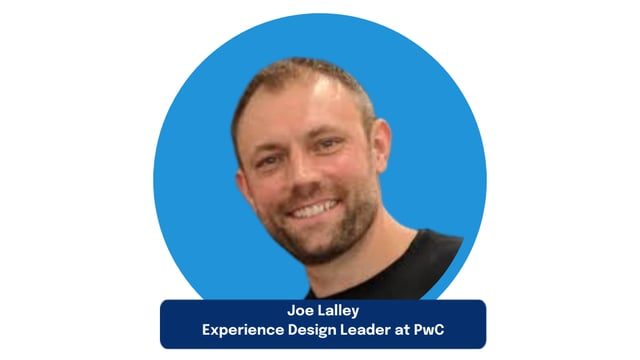Transferring Excitement is Product Management

Joe Lalley, Experience Design Leader at PwC, shares how to use design to create innovative workshops and train people on how to change the way they work.
Joe Lalley is an Experience Design Leader at PwC, a massive professional services organization, where he leads a team to design innovative workshops and trainings for internal teams. In the U.S. alone, there are about 50,000 employees within the firm, and Joe’s team works with them to improve and innovate a myriad of initiatives, solutions, products, and digital experiences.
No matter the project, Joe works to apply user-centered design thinking and experimentation principles. He and his team use a number of innovative techniques, including designing and facilitating workshops, redesigning physical office spaces, rethinking meeting structures, and becoming embedded parts of teams to change mindsets.
One of the most successful training models has been workshops, where they help internal PwC teams learn new skills or train them on specific project use cases.
The benefit of a workshop in that instance, Joe says, is that user research, ideation, experimentation, testing, and validating work can be condensed into a shorter time frame. “In many cases, on many projects, these phases can be spaced out over time, followed by a meeting, some reviews and decisions,” he says. “I feel like you really lose momentum, and you almost lose connection to the problem you're trying to solve.”
The workshops don’t have to take place in person, either. In fact, after some experimentation, many of Joe’s workshops are now intentionally designed to be remote.
After successfully conducting a number of in-person workshops, a situation arose where an internal group wasn’t able to travel and be on-site for a workshop. Joe and his team struggled with how to design a workshop experience that would work in a remote environment. He decided to take some of the advice he doles out to internal teams and reframe the situation. Instead of thinking about a remote workshop as something to overcome, he flipped the thinking on its head: How can a remote workshop be an advantage? “We learned along the way that in-person isn’t always a requirement,” he says. “That was a springboard into one of the models that we now use on a very regular basis.”
The workshops have been impactful at PwC. But one challenge has been spreading the knowledge and learnings across the company, and it’s especially challenging for an organization of PwC’s size. “Teams would leave a workshop with us feeling really energized. But they would then rejoin their teams or go to their bosses, and it was a challenge for them to get those people excited about it in the same way that they were,” Joe says.
To combat that, they focus on transferring excitement, which is just as important as transferring knowledge. After teams have tested and validated concepts at workshops, Joe prepares people to leave the workshops. He implores them to think critically about the questions their coworkers will ask when they bring their ideas back to their work. Practicing their responses to these questions helps them think about what meaning they want to have. It’s about bringing to meetings “anything that is really real and tangible, that somebody else can connect to, to feel the feeling that they have,” he says.
You’ll learn a lot in this episode about new approaches to innovation training and how to rally stakeholders around new ideas.
Here are the highlights:
- The strategies Joe uses to apply user-centered design thinking and experimentation principles (4:55)
- How to generate excitement about new ideas (16:40)
- Joe’s insights on having more productive meetings (24:22)

Subscribe now!
Get our new reports, case studies, podcasts, articles and events
